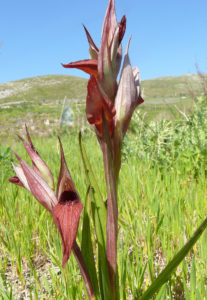Fungal and plant gene expression provides clues to nitrogen pathways.

Researchers investigated Tulasnella calospora as both a free-living mycelium and in symbiosis with the photosynthetic orchid long-lipped serapias. (Ziegler175, Wikimedia Commons, CC BY-SA 3.0)
The Science
Orchids are an example of an experimentally tractable plant that is highly dependent on its relationship with its mycorrhizal fungal partners for nutrient supply. In this recent study, researchers for the first time identified some genetic determinants potentially involved in nitrogen uptake and transfer in orchid mycorrhizas.
The Impact
This study provides a model system amenable to experimental manipulation, for plant-fungi nutrient exchanges on a symbiotic level and offers insights into how host plants benefit from the mutualistic relationships formed with soil fungi which can expand their habitat range. Understanding these vital relationships may shed light on microbial symbioses applicable to growing bioenergy feedstock plants.
Summary
Orchids, like the majority of terrestrial plants, form symbiotic relationships between their plant roots and soil fungi, known as mycorrhizal association. However, unlike other terrestrial plants, orchids rely on their mycorrhizal fungal partners for nutrient supply during the feed germination and development stages. Following this stage, most orchid species develop leaves and are capable of self-nourishment whereas some species continue to rely on their fungal partners for an organic carbon supply. In this study, published in the January 2017 issue of New Phytologist, a team led by University of Turin researchers investigated the orchid mycorrhizal fungus Tulasnella calospora as both a free-living mycelium and in symbiosis with the photosynthetic orchid long-lipped serapias, or Serapias vomeracea. For the first time, researchers looked at the fungal genes that may have been involved in both the uptake and transfer of nitrogen to the host plant. RNA sequencing for the project was performed at the U.S. Department of Energy Joint Genome Institute (DOE JGI), a DOE Office of Science User Facility, as part of the 2013 Community Science Program portfolio.
The team also used the DOE JGI fungal genome database MycoCosm to identify fungal genes coding for proteins that were involved in nitrogen uptake and transfer. They found that the Tulasnella calospora genome has two genes coding for ammonium transporters and several genes coding for amino acid transporters, proteins that play roles in the nitrogen nutrient pathway. Overall, the orchid mycorrhizal fungi’s use of nitrogen may broaden the habitat ranges of orchids, allowing them to grow in a variety of soil types. Of more general interest to the DOE, this study provides important insights for this process, and furthers understanding of plant-microbial symbioses that are vital for plant health and may inform understanding of microbial symbioses relevant to bioenergy feedstock plants.
Contacts
Daniel Drell, Ph.D.
Program Manager
Biological Systems Sciences Division
Office of Biological and Environmental Research
Office of Science
U.S. Department of Energy
[email protected]
Silvia Perotto
University of Turin
[email protected]
Funding
- U.S. Department of Energy Office of Science
- Ministry of Education, Universities, and Research (Italy)
- University of Turin
- ‘Compagnia di San Paolo’ (Torino, Italy)
- Laboratory of Excellence Advanced Research on the Biology of Tree and Forest Ecosystems (ARBRE)
Publication
- V. Fochi, W. Chitarra, A. Kohler, S. Voyron, V. Signan, E. Lindquist, K. Berry, M. Girlanda, I.V. Grigoriev, F. Martin, R. Balestrini, and S. Perotto, “Fungal and plant gene expression in the Tulasnella calospora–Serapias vomeraceasymbiosis provides clues about nitrogen pathways in orchid mycorrhizas” New Phytologist (2017). doi: 10.1111/nph.14279
Related Links
- MycoCosm Fungal Genomes Portal
- Community Science Program
- MycoCosm: Tulasnella calospora
- Community Science Plans FY 2013: The Mycorrhizal Genomics Initiative
- MycoCosm: Sebacina vermifera
- MycoCosm: Ceratobasidium sp.
- Community Science Plan FY 2016: Microbial Mutualism with Orchids